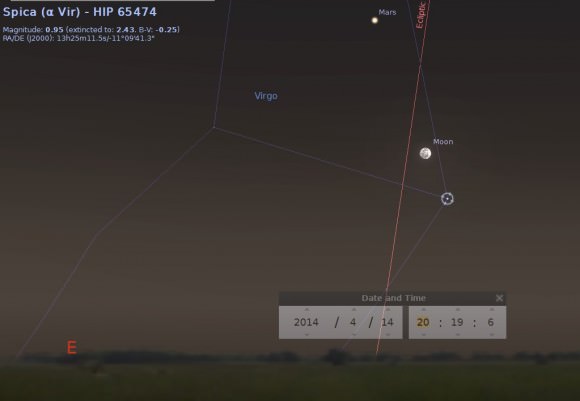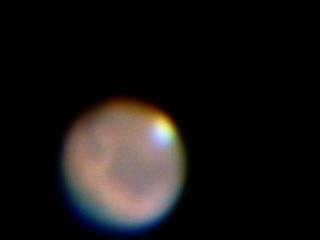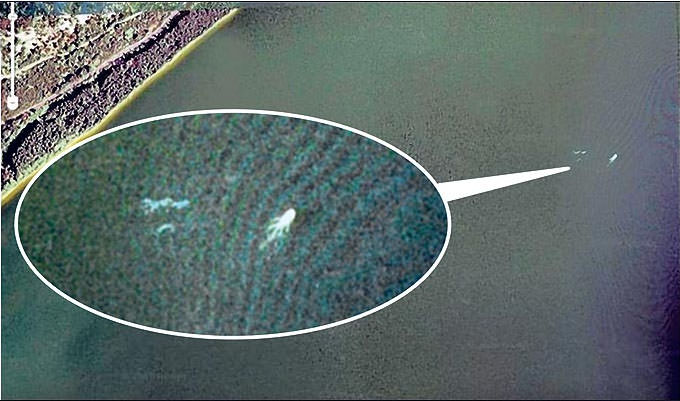A 2023 expedition to the Pacific Ocean, searching for debris from a suspected extraterrestrial object, may have been looking in the wrong place. A new look at the infrasound data used to locate the point of impact suggests that they may have been confused by the rumblings of a truck driving past.
Continue reading “The Sound of an Interstellar Meteor Might Have Just Been a Rumbling Truck”“Bright Light” on Mars is Just an Image Artifact

Thanks to everyone who has emailed, Tweeted and texted me about the “artificial bright light” seen on Mars. And I’m so sorry to disappoint all the folks who were hoping for aliens, but what you see above is just an image artifact due to a cosmic ray hitting the right-side navigation camera on the Curiosity rover.
If you do a little research, you can see that the light is not in the left-Navcam image that was taken at the exact same moment (see that image below). Several imaging experts agree this is a cosmic ray hit, and the fact that it’s in one ‘eye’ but not the other means it’s an imaging artifact and not something in the terrain on Mars shooting out a beam of light.
Update: JPL imaging specialists with the MSL mission have now weighed in on these images. “In the thousands of images we’ve received from Curiosity, we see ones with bright spots nearly every week,” said Justin Maki in a press release from JPL. Maki is leader of the team that built and operates the Navigation Camera. “These can be caused by cosmic-ray hits or sunlight glinting from rock surfaces, as the most likely explanations.”
If the bright spots in the April 2 and April 3 images are from a glinting rock, the directions of the spots from the rover suggest the rock could be on a ridge about 175 yards (160 meters) from the rover’s April 3 location.
The bright spots appear in images from the right-eye camera of the stereo Navcam, but not in images taken within one second of those by the left-eye camera. Maki said, “Normally we can quickly identify the likely source of a bright spot in an image based on whether or not it occurs in both images of a stereo pair. In this case, it’s not as straightforward because of a blocked view from the second camera on the first day.”
There’s a great discussion and analysis of this going on at UnmannedSpaceflight.com, and they seem to be leaning towards the cosmic ray explanation.
You can see the whole series of images from the right Navcam here.

Cosmic ray hits happen frequently on spacecraft that don’t have the benefit of being in Earth’s thick atmosphere. And frequently, people seem to get excited about what shows up in imagery that have been affected. For example, one guy thought there was a huge base on Mars based on some he saw on Google Mars.
Getting hit by a cosmic ray can have some serious consequences for a spacecraft — sometimes it can put them into what’s called “safe mode” where only basic functions operate, or other times it can mess up data (like what happened with Voyager 2 in 2010 where the data sent back to Earth was unreadable). Usually, engineers are able to fix the problem and get the spacecraft back in working order.
Cosmic rays can even show up in imagery taken by astronauts on the International Space Station, like this one by astronaut Don Pettitt in 2012:

Astronauts also report seeing flashes — even with their eyes closed — whenever cosmic rays zip through their eyeballs. You can read more about that here.
And so far, none of these blips, lights or flashes seen on space imagery has ever been “because aliens.”
If you really want to see some amazing things, look at the imagery taken by Curiosity in its currently location on Mars. See all the raw images here, or see some really great colorized and enhanced versions on ‘amateur’ imaging blogs like those by Stuart Atkinson, James Canvin, Damia Bouic, Emily Lakdawalla at the Planetary Society, or the work done by Ken Kremer here on Universe Today.
Additionally, if you want to see bright lights associated with Mars, all you have to do is look up in the sky at night and see Mars shining brilliantly in the sky right now. Mars is in opposition, where it is closest to the Earth, and the “official” closest moment happens today, April 8th! Find out more about how to see it or watch different webcasts taking place today at our previous article here.

And for those of you who think we shouldn’t give “air time” to nutty claims like lights on Mars, it is our policy to address and debunk such claims (for example, see our article debunking the latest end of the world claim) in order to make sure the real story and good doses of reality are out there, too, and available to people who are looking for the real story.
Calm Down: NASA Hasn’t Found any Aliens

[/caption]
You may have heard in your wanderings through the blogosphere and in the internet today that NASA will be holding a press conference on December 2nd in which they will make an announcement regarding information the search for extraterrestrial life. And that this announcement involves astrobiology, the study of life outside what we know about here on Earth. While true, it is nothing to get worked up about.
Speculation abounds that this is, “the big one,” and that an announcement will be made that extraterrestrial life has been discovered. You can find this speculation at Kottke.org, io9, Gawker, and a lot of other places.
To be clear, there is almost no chance that the press release will be announcing little green men or little brown bacteria anywhere. Follow along for the long explanation below the fold.
Here’s what the press release is titled: “NASA Sets News Conference on Astrobiology Discovery: Science Journal Has Embargoed Details Until 2 p.m. EST On Dec. 2”. All this means is that Science Journal will be publishing some results related to astrobiology that are under embargo until that time. The embargo system is a basically a way of allowing journalists to see scientific results and get interviews and do research on an article before it’s published, but only if they promise to publish their information after the original publication does so. It makes sense, and it works most of the time to the benefit of almost everyone.
NASA regularly – like every day – announces upcoming press conferences and releases, and embargoed press releases float around to science writers like those of us here at Universe Today. This in itself is nothing out of the ordinary, and anyone with an email address can sign up to have these announcements delivered to their inbox or view them on NASA’s website. These emails are meant mainly to notify members of the press that there is something coming up worthy of being a phone-in listener of, the details of which require you to have press credentials.
The press release goes on to say,
“NASA will hold a news conference at 2 p.m. EST on Thursday, Dec. 2, to discuss an astrobiology finding that will impact the search for evidence of extraterrestrial life. Astrobiology is the study of the origin, evolution, distribution and future of life in the universe.
The news conference will be held at the NASA Headquarters auditorium at 300 E St. SW, in Washington. It will be broadcast live on NASA Television and streamed on the agency’s website at http://www.nasa.gov.
Participants are:
– Mary Voytek, director, Astrobiology Program, NASA Headquarters, Washington
– Felisa Wolfe-Simon, NASA astrobiology research fellow, U.S. Geological Survey, Menlo Park, Calif.
– Pamela Conrad, astrobiologist, NASA’s Goddard Space Flight Center, Greenbelt, Md.
– Steven Benner, distinguished fellow, Foundation for Applied Molecular Evolution, Gainesville, Fla.
– James Elser, professor, Arizona State University, Tempe”
And that’s about it. My first reaction to this was that they had potentially made the discovery of exotic, new organic molecules in an exoplanetary atmosphere, or that some chemical conducive to the existence of life as we know it was possibly found on some body in the Solar System. Announcements like this come out of NASA all of the time.
Just because some of the participants do work in fields that are related to oceanography or ecology or biology, does not mean that their services are required here to help make an announcement that life other than that on Earth has been discovered, as other speculative bloggers might think.
As Nancy wrote in a post earlier today, extraterrestrial life is very much of interest to Universe Today readers. Which is why she’ll be listening in on that news conference Thursday, and reporting what findings are released.
Extraterrestrial life is very much of interest to probably most of the population of our planet, too, and the fact that we have the tools necessary to potentially make this discovery within the next few hundred years (or sooner), is really, really exciting.
But just because it’s exciting doesn’t mean we have to jump all over a NASA press release that includes the words “extraterrestrial life” or “precursor to life on Mars” and make wild speculations. When that announcement is made (or if, depending on how you choose to solve the Drake Equation), you can be sure that it will be very closely guarded until being made public, and after that the President will likely have some things to say.
For some more level-headed analysis, Keith Cowing at Nasa Watch has some much more reasonable speculation that the announcement involves arsenic biochemistry. The Bad Astronomer, Phil Plait, also has a good debunking of the rampant speculation, and makes some good points about how NASA can create press releases in the future that have better-worded announcements.
So calm down – but don’t stop looking up! Keep being excited about all of the genuinely cool and exciting developments we’re currently making with regards to space.
Source: NASA press release
Debunking Astrology: Mars Can’t Influence You
So you think the position of Mars in the sky at the time of your birth made you tall, dark, and handsome (or short, fair, and ugly)? Or lucky (or unlucky) in love? If you think believing in astrology is anywhere close to scientific, well, Dude, time to think again.
Pick two babies born within a minute of each other. One has two nurses and a doctor attending; the other, just a midwife. One is born in a brightly lit maternity ward in a downtown big city hospital; the other in a poorly lit room in a village 50 kilometers from the nearest big city. ‘Downtown’ is just a few meters above sea level; the village is situated on a 1000 meter high plateau. These local differences have far greater effects on the babies than Mars does. Let’s see how.
Nearly five centuries of physics have given us quite a few certainties, and among those are that the only long range forces in the universe are gravity and electromagnetism. And both of these, from Mars, are totally – and I mean totally – overwhelmed by those same forces that were produced by things near you when you were delivered. In a word, Mars can’t influence you.
Start with gravitation.
The gravitational force between you and Mars is greatest when Mars is closest to the Earth; let’s say that’s 56 million kilometers. Now Mars has a mass of 6.4 x 1023 kg, so the acceleration, here on Earth, due to Martian gravity would be 1.4 x 10-8 meters per second per second (m s-2).
How did I work that out? By using Newton’s law of universal gravitation:
F = Gm1m2/r2
and:
F = ma
so:
a = GmMars/distance-to-Mars2.
How does this compare with variations in gravitational force due to adults standing nearby (everyone has a mother, so we won’t count her)?
Let’s take 60 kg as an adult’s mass, and a distance of 1 meter; that gives a gravitational acceleration of 4 x 10-9 m s-2, so just three adults nearby would have the same gravitational effect on you as Mars!
How does this compare with variations in gravitational force we know people born at the same time – but elsewhere on Earth – experienced?
Let’s take a difference in altitude of 1000 m (lots of big cities have altitudes greater than this – Mexico City, for example, is at 2240 m – and lots are close to sea level), and calculate the difference in acceleration due to the Earth’s gravity (this ignores several important factors, such as the Earth’s rotation, and local differences in g). Well, it works out as 0.003 m s-2, or about 200,000 times greater than Martian gravity!
In fact, if you were born just half a centimeter higher, you’d be influenced to the same extent, gravitationally, as by Mars!
Next, electromagnetism.
You can be influenced, electromagnetically, in four separate ways: by a magnetic field, by an electric current, by an electric field, and by electromagnetic radiation. How powerful is Mars, electromagnetically?
There’s no electric current between Mars and Earth; the solar wind – which blows outward from the Sun (so Mars is ‘downstream’, and any electromagnetic influence carried by the solar wind would be from Earth to Mars) – is neutral, on balance, and carries no current.
The solar wind is a plasma, and any electric field there is in it will not be felt much more than a few Debye lengths’ away (basically, because electrons and ions are free to move in a plasma, they screen charges – the source of electric fields – quite effectively; the Debye length is about as far as an electric field can penetrate). Now the solar wind can be quite dynamic – meaning it can change a lot – but the Debye length in any part of it will rarely, if ever, be greater than a few tens of meters. Let’s be generous and say an electric field could be felt up to a kilometer away. But Mars never comes closer to the Earth than ~50 million km!
Well, that makes any electric field influence from Mars impossible, doesn’t it?!
While Mars does have a weak magnetic field, it has no influence on Earth, because the Earth’s own field creates a magnetosphere around us, one that screens out external magnetic fields. Besides, as Mars is downstream from us (the way the solar wind blows), and as the solar wind can carry (actually stretch) a magnetosphere only in the direction it blows, any magnetic influence would be from Earth to Mars, not Mars to Earth.
Three down, one to go.
The Earth’s atmosphere blocks all electromagnetic radiation except for that which we see by (and a bit on the UV side too), some infrared, and in the microwave and radio regions of the electromagnetic spectrum.
Mars is a very weak source of microwaves and radio waves, and even in the (radio) quietest places on Earth, electromagnetic radiation from (distant) radio stations, (distant) cellphone towers, TV satellites, airplanes overhead, etc totally, totally drowns out any Martian signals.
On a clear, moonless night, Mars may seem bright to your dark-adjusted eyes … but most likely you were born under quite bright lights, and indoors. No Martian influence here either.
So what do we have then?
Like I said, Mars can’t make you tall dark and handsome, nor can it influence your love life.
Loch Ness Monster On Google Earth?
[/caption]
As only a British tabloid (and Fox News) could, reports came out this week of the Loch Ness Monster being spotted on Google Earth. “This amazing image on Google Earth could be the elusive proof that the Loch Ness Monster exists,” The Sun reported. Well, for one thing, this doesn’t look *anything* like Nessie. Doesn’t he have a long black neck? And another thing about this: it looks surprisingly like a …. boat. Imagine that, a boat on a lake captured by Google Earth! Astounding!
 Look closely and you’ll see the squared off back end of the boat (the stern), the rounded
Look closely and you’ll see the squared off back end of the boat (the stern), the rounded stern bow in front, and the tentacle-looking things are just the boat’s wake. This looks very much like another image of a boat on Loch Ness on Bing (below). Click on the picture to get to the image on Bing and zoom out for the full effect.

To see it on Google Earth, go to coordinates Latitude 57°12’52.13″N, Longitude 4°34’14.16″W. Take a tour of Loch Ness (it is pretty there!) and you’ll see lots of other suspicious looking white things in the lake that are (gasp!) more boats!



